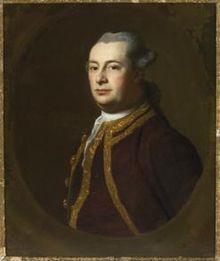
Michael Francklin or Franklin (6 December 1733 – 8 November 1782) served as Nova Scotia's Lieutenant Governor from 1766 to 1772. He is buried in the crypt of St. Paul's Church (Halifax).
Early life and immigration
Born in Poole, England, Francklin immigrated to Halifax, Nova Scotia in 1752. He worked as a trader and merchant, initially in association with Joshua Maugher.
Capture
During Father Le Loutre's War, Michael Francklin was captured by a Mi'kmaw raiding party in 1754 and held captive for three months in which he learned the Mi'kmaw language and developed an appreciation for native culture.[1]
Political career


Francklin represented Lunenburg County from 1759 to 1760 and Halifax County from 1761 to 1762 in the Nova Scotia House of Assembly.
In May of 1762, he was named to the Nova Scotia Council.
In the early 1770s, he was responsible for bringing about the Yorkshire Emigration. He also played an important role in assisting the return of Acadians after the Expulsion of the Acadians by guaranteeing Catholic worship, land grants and a promise that there would be no second expulsion.
He established the Shubenacadie reserve in 1779.[2]
Family
On February 7, 1762, Francklin married Susannah Boutineau (b. 1740). Susannah died at Windsor, Nova Scotia, April 19, 1816 in her 76th year and is buried at the Old Parish Burying Grounds. She was the daughter of Joseph and Susannah (Faneuil) Boutineau, and granddaughter of Benjamin Faneuil.[3]
Susannah and Michael had the following children:[3]
- James Boutineau, born July 31, 1763.
- Elizabeth Mauger, born September 3, 1764.
- Susannah, born August 23, 1765. m (1) . Benjamin Davis of Pennsylvania, m (2)
- Ann, born August 31, 1767.
- Joshua Mauger, born September 1, 1869
- Michael Nickleson, born August 20, 1773.
- John Robinson, born July 6, 1774.
- George Sackville Germain, born January 15, 1777.
- Mary Phillipps, born October 7, 1779.
- Sarah Nickleson, born December 21, 1780.
Death
He died at home in Halifax in 1782. Many Mi'kmaq attended his funeral at St. Paul's Church (Halifax).
Legacy
The Francklins long made their chief home at Windsor, and were among the most active supporters of the Anglican Church in that town. Lieutenant-Governor Francklin gave the land for the parish church (Christ Church) and churchyard at Windsor, and Mrs. Francklin gave, April 28, 1801, an acre of land opposite the church for a parsonage, and in 1815 a complete set of service books, including a handsomely-bound folio Bible, for use in public worship.[3][4]
- namesake of Francklyn Street, Halifax, Nova Scotia[5]
- namesake of Fort Franklin, Tatamagouche, Nova Scotia (1768) [6]
- namesake of Mi'kmaq reserve Franklin Manor 22, Nova Scotia[7]
-
Susannah (Boutineau) Francklin (1762) by John Singleton Copley (wife of Michael Franklin; grandchild of Peter Faneuil), Uniacke Estate Museum Park
-
Susannah Boutineau by Robert Feke (1748), (mother-in-law of Michael Francklin), Uniacke Estate Museum Park
See also
References
Endnotes
- ^ Fischer, L. R. (1979). "Francklin, Michael". In Halpenny, Francess G (ed.). Dictionary of Canadian Biography. Vol. IV (1771–1800) (online ed.). University of Toronto Press.
- ^ Murdoch, Beamish (1866). A History of Nova-Scotia, Or Acadie. Vol. II. Halifax: J. Barnes. p. 600.
- ^ a b c Fales, De Coursey (1919). The Fales family of Bristol, Rhode Island : ancestry of Haliburton Fales of New York. Boston: T. R. Marvin & Son.
 This article incorporates text from this source, which is in the public domain.
This article incorporates text from this source, which is in the public domain.
- ^ [1] (p. 183)
- ^ NS Archieves
- ^ Frank Patterson. Acadian Tatamagouche and Fort Franklkin, p.75
- ^ "Place-names of the Province of Nova Scotia". Halifax, N.S. Royal Print. & Litho. 1922.
Texts
- James S. Macdonald, "Lt. Governor Michael Francklin, 1752-1782" Collections of the Nova Scotia Historical Society; (40 pp.) vol. 16 (1912)
- W. B. Kerr, "The Rise of Michael Francklin" (7 pp.) The Dalhousie Review, Vol. 13 (1934), No. 4.
External links
- Biography of Michael Francklin
- Memoir of Michael Franklin Collections of the Nova Scotia Historical Society




Recent Comments